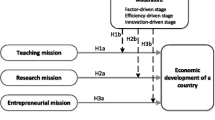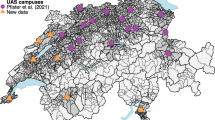Abstract
In recent years several regions have created development strategies to strengthen the regional economic and innovation contribution of universities. Still, it is not at all obvious whether universities’ significant regional contribution is a rule or rather an exception, especially in transition and less developed areas. Present paper addresses three crucial fields that seem to be problematic in the literature. First, we analyze universities’ regional contribution in a transition economy, namely in Hungary. Second we attempt to capture territorial innovation performance by applying an innovation system based approach. Third, we carry out a nationwide analysis on a subregional level. We conclude that regional contributions of Hungarian higher education institutions are modest, way too forceless to catalyze the local economy.
Similar content being viewed by others
Notes
The ways of strengthening the income effects are, on the one hand, the increase of the number of students and the staff, on the other hand, the rise of the proportion of local spending. These face objective hindrances (e.g. public procurement rules do not allow the university to prioritize local buying). Therefore the strengthening of the income effects is not an objective of local economic development.
Although the Bay–Dole Act was adopted in 1980, its effects became measurable only a few years later.
Defined by the Government Regulation 244/2003.
The computing method of the two indexes is outlined later in the chapter.
GDP is not available for LAU-1 subregions, thus GVA is used as a substitute.
Goldstein and Renault (2004) used the wages as dependent variable, but in this case we also had to face the unavailability of the data in subregional level.
The index considers the time distance from the nearest county-centre (40%), from the nearest subregion-centre (40%), and the state of supply (20%), which latter indicates the extent to which the residents are dependent on the services of the centres. Accessibility is calculated for all the municipalities and then, weighted by the population of the municipalities, the subregional index is calculated.
The detailed results of this subregional innovation measurement exercise is available in Bajmócy and Szakálné (2009).
The Summary Innovation Index of the European Innovation Scoreboard (EIS 2008), the Service Sector Innovation Index of the European Trend Chart on Innovation (Kanerva et al. 2006), the EXIS Summary Index (Arundel and Hollanders 2005), the National Innovative Capacity Index of Porter and Stern (2003), the Europe Creativity Index of Florida and Tingali (2004), the RRSI Index of the European Regional Innovation Scoreboard (Hollanders 2006), the analysis of Csizmadia and Rechnitzer (2005) regarding the innovation potential of Hungarian cities.
During the calculation of the minimum and maximum value of an indicator we removed the outliers (if its distance from the national average exceeded the standard deviation for more than four times). The rescaled values of these figures are zero or one depending on the direction of deviation.
Change in per capita GVA compared to the national average in percentage points is −14.68 in case of the study population and 7.15 in case of the control group. If we compare subregions with and without universities (instead of with and without HEIs) the values are −16.37 and 3.12, respectively.
Change in gross tax base per tax payer compared to the national average in percentage point is −0.73 in case of the study population and 0.56 in case of the control group.
We provided detailed description of the method in “The steps of the analysis”.
This does not infer the lack of HEIs contribution in all the subregions, but this potential catalytic role is far from being general.
References
Anselin L, Varga A, Ács JZ (1997) Local geographic spillovers between university research and high technology innovations. J Urban Econ 42(3):422–448
Antonelli C (2008) The new economics of the university: a knowledge governance approach. J Technol Transfer 33:1–22
Armstrong H, Taylor J (2000) Regional economics and policy, 3rd edn. Blackwell, Oxford
Arundel A, Hollanders H (2005) EXIS: an exploratory approach to innovation scoreboards. European trend chart on innovation. European Commission, Maastricht
Asheim BT, Coenen L (2005) Knowledge bases and regional innovation systems: comparing nordic clusters. Res Policy 34:1173–1190
Audretsch DB, Feldman MP (1996) R&D spillovers and the geography of innovation and production. Am Econ Rev 86(3):630–640
Autant-Bernard C (2001) Science and knowledge flows: evidence from French case. Res Policy 30(4):1069–1078
Bajmócy Z (2006) Opportunities of university business incubation in less favoured regions of transition countries. In: 46th congress of European Regional Science Association, Volos, Greece. http://ideas.repec.org/p/wiw/wiwrsa/ersa06p190.html
Bajmócy Z, Szakálné Kanó I (2009) Measuring the innovation performance of Hungarian subregions. In: Bajmócy Z, Lengyel I (eds) Regional competitiveness, innovation and environment. JATEPress, Szeged, pp 99–121
Bercovitz J, Feldman M (2006) Entrepreneurial universities and technology transfer: a conceptual framework for understanding knowledge-based economic development. J Technol Transfer 31:175–188
Bosma N, Harding R (2006) Global Entrepreneurship Monitor. GEM 2006 Summary Results. Babson College, London Business School. Babson Park, London
Buzás N (2003) Organizational elements of knowledge transfer in Hungary: towards a functional system of innovation. In Lengyel I (eds) Knowledge transfer, small and medium-sized enterprises and regional development in Hungary. JATE Press, Szeged, pp 32–46
Clarysse B, Wright M, Lockett A, van de Velde E, Vohora A (2005) Spinning out new ventures: a typology of incubation strategies from European research institutions. Res Policy 20(2):183–216
Cooke P (2004) Regional innovation systems, an evolutionary approach. In: Cooke P, Heidenreich M, Braczyk HJ (eds) Regional innovation systems. The role of governance in a globalized world. Routledge, London, pp 1–18
Csizmadia Z, Rechnitzer J (2005) A magyar városhálózat innovációs potenciálja. In: Grósz A, Rechnitzer J (szerk.) Régiók és nagyvárosok innovációs potenciálja Magyarországon, MTA RKK, Pécs, Győr, pp 147–180
Csizmadia Z, Erdős F, Grosz A, Smahó M, Tilinger A (2008) Innováció a Nyugat-Dunántúlon, 2008. MTA RKK, Pécs, Gy
Doloreux D (2002) What should we know about regional systems of innovation. Technol Soc 24:243–263
Edquist C (2005) Systems of innovation approaches. Their emergence and characteristics. In: Edquist C (ed) Systems of innovation. Technologies, institutions and organizations. Routledge, London, pp 1–35
EIS (2008) European innovation scoreboard 2008. Comparative analysis of innovation performance. Inno Metrics, Bruxelles
Etzkowitz H, Leydesdorff L (2000) The dynamics of innovation: from national system and “Mode 2” to a triple helix of university–industry–government relations. Res Policy 2:109–123
Etzkowitz H, Webster A, Gebhardt C, Terra BRC (2000) The future of the university, the university of the future: evolution of ivory tower to entrepreneurial paradigm. Res Policy 2:313–330
Feldman PM (1994) The university and economic development: the case of Johns Hopkins University and Baltimore. Econ Develop Q 8(1):67–76
Florida R, Tingali I (2004) Europe in the creative age. DEMOS. http://www.demos.co.uk/publications/creativeeurope
Goldfarb B, Henrekson M (2003) Bottom-up versus top-down policies towards the commercialization of university intellectual property. Res Policy 32:639–658
Goldstein H, Renault CS (2004) Contributions of universities to regional economic development: a quasi-experimental approach. Region Stud 38(7):733–746
HCSO (2004) A statisztikai kistérségek 2002–2003-as felülvizsgálatának összefoglaló eredményei. Munkaanyag. Központi Statisztikai Hivatal (Hungarian Central Statistics Office), Budapest
Hollanders H (2006) European regional innovation scoreboard. European Trend Chart on Innovation, Maastricht
Inzelt A (2004) The evolution of university, industry, government relationships during the transition. Res Policy 33(6–7):975–995
Inzelt A, Szerb L (2003) Az innovációs aktivitás vizsgálata ökonometriai módszerekkel. Közgazdasági Szemle 50(11):1002–1021
Kanerva M, Hollanders H, Arundel A (2006) Can we measure and compare innovation in services. 2006 Trend Chart Report. European trend chart on innovation, Luxemburg
Lengyel I (2009) Knowledge-based local economic development for enhancing competitiveness in lagging areas of Europe: the case of the University of Szeged. In Varga A (ed) Universities, knowledge transfer and regional development. Geography, Entrepreneurship and Policy. Edward Elgar, Cheltenhem, pp 321–349
Lengyel B, Cadil V (2009) Innovation policy challenges in transition countries: foreign business R&D in the Czech Republic and Hungary. Trans Stud Rev 16:174–188
Lukovics M (2008) Measuring regional disparities: evidence from Hungarian sub-regions. In: Paper presented at the “Culture, cohesion and competitiveness: regional perspectives” 48th congress of the European Regional Science Association, Liverpool, UK
Lundval BA (eds) (1992) National systems of innovation. Towards a theory of innovation and interactive learning. Pinter, London
Lundvall BA, Johnson B, Andersen ES, Dalum B (2002) National systems of production, innovation and competence building. Res Policy 31:213–231
Malecki EJ (1997) Technology and economic development: the dynamics of local, regional and national competitiveness. Longman, Edinburgh
Morgan B (2002) Higher education and regional economic development in Wales: an opportunity for demonstrating the efficacy of devolution in economic development. Region Stud 36(1):65–73
Nelson RR (eds) (1993) National innovation systems. A comparative analysis. Oxford University Press, New York
Nelson RR (1995) Recent evolutionary theorizing about economic change. J Econ Lit 33(3):48–90
Porter ME, Stern S (2003) The impact of location on global innovation: findings from the national innovative capacity index. The Global Competitiveness Report 2002–2003, WEF, pp 227–252
Tödtling F, Trippl M (2005) One size fits all? Towards a differentiated regional innovation policy approach. Res Policy 34:1203–1209
Varga A (1998) University research and regional innovation: a spatial econometric analysis of academic technology transfers. Kluwer, Boston
Varga A (2004) Az egyetemi kutatások regionális gazdasági hatásai a nemzetközi szakirodalom tükrében. Közgazdasági Szemle 51(3):259–275
Varga A (2009) Térszerkezet és gazdasági növekedés. Akadémiai Kiadó, Budapest
Acknowledgments
The research was supported by the Baross Gábor Innovation Analysis programme of the Hungarian National Office for Research and Technology (BAROSS-DA07-DA-ELEM-07-2008-0001). We are grateful for their comments on the earlier versions of this paper to Imre Lengyel, Philippe Laredo, Andreas Niederl and Siri Brorstad Borlaug.
Author information
Authors and Affiliations
Corresponding author
About this article
Cite this article
Bajmócy, Z., Lukovics, M. & Vas, Z. A Subregional Analysis of Universities’ Contribution to Economic and Innovation Performance. Transit Stud Rev 17, 134–150 (2010). https://doi.org/10.1007/s11300-010-0128-4
Received:
Accepted:
Published:
Issue Date:
DOI: https://doi.org/10.1007/s11300-010-0128-4




